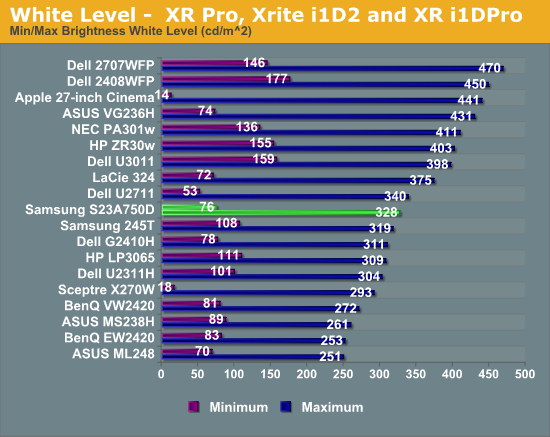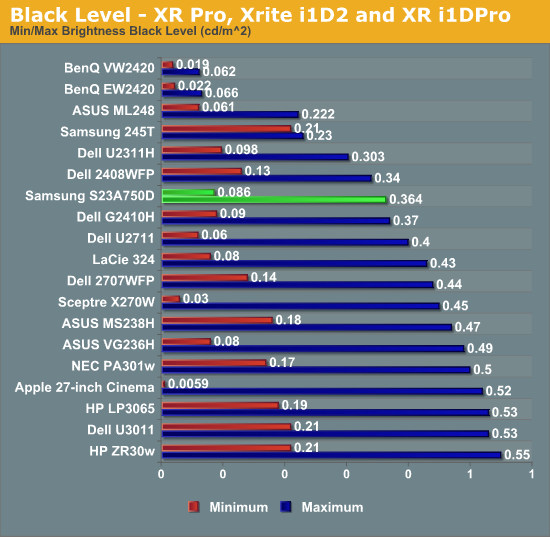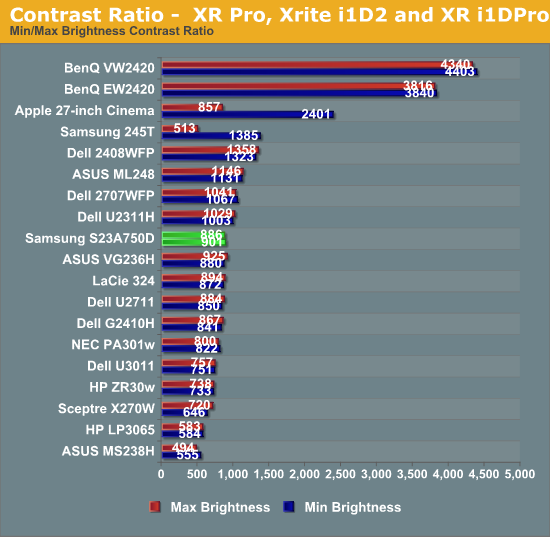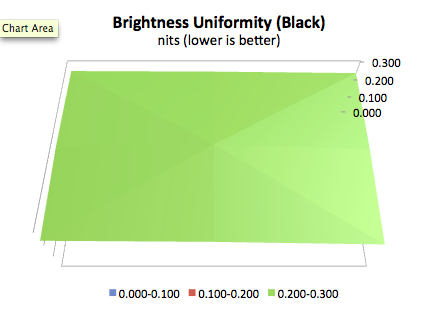Samsung S23A750D 3D LCD Display
by Chris Heinonen on December 17, 2011 2:45 PM ESTSamsung S23A750D Brightness and Contrast
The S23A can produce more light output than many monitors, with over 300 nits of light output possible. While in most cases I would say this kind of light output is a crazy amount that few people will use, the highly glossy screen on the Samsung might make this much light output useful if you have a lot of reflections around your work area from windows or overhead lights. Additionally, Active 3D glasses will cut the light output in more than half, as each eye only views the display half the time and they have tint to them, so ~25% of that light output would be 80 nits. It also manages 76 nits with the backlight brightness set to the minimum, so that gives you a very wide range to adjust the monitor to your preference.

The black output level on the Samsung falls right into the expected range for the monitor. I was a bit disappointed with this as Samsung has managed to get darker blacks out of their LED edgelit TVs, so I was hoping more of that technology would copy over to their monitors. As it is, it’s a little on the bright side for a monitor of this size.

Despite the brighter whites, the black levels rise as well and so the contrast ratios are a pedestrian 900:1 on average. That's neither spectacular nor disappointing; the contrast ratio is merely average for 2011. As usual, we test without dynamic contrast enabled, as the change in backlight intensity tends to be visible and distracting, though Samsung claims up to a 5 million to 1 contrast ratio with dynamic backlighting. (I'm not sure how they'd get there, considering the maximum white level divided by the minimum black level only results in a contrast of 3813:1; they would almost need to shut off the backlight entirely to get down to the necessary 0.000064 nits black level.)

The brightness uniformity of the S23A comes in as merely average as well. With the center at just over 200 nits, only one other area of the screen measured over 190 nits, and only one more was even over 180 nits, with the lower right of the screen measuring over 20% darker than the center.

The black uniformity was a little better, though the higher black level overall meant that none of the values were spectacular. The same lower-right area that was darker in the brightness measurements was also darkest in the black measurements, so the backlight just seems to not be as powerful in that area.











80 Comments
View All Comments
sviola - Monday, December 19, 2011 - link
Well, I hope it doesn't take much longer. Also, I hope they'll release them with 16:10 aspect ratio.DanNeely - Monday, December 19, 2011 - link
It'd be nice if they manage to get top flight LED backlight color accuracy above that of top flight CFL models before the 120hz refresh too.MadAd - Sunday, December 25, 2011 - link
This is my problem too.I have a triple desktop including x2 1920x1200 IPS screens. Any new 120hz monitor has to fit in, in the center, 1080 isnt going to work.
Why cant we get
-120hz
-displayport
-1200 lines
in one package? I could even wait for IPS, but the aspect ratio is a dealbreaker.
MadAd - Sunday, December 25, 2011 - link
-24"(forgot that one)
The only one ive seen even close is that horrible shape one for an insane amount of money
dingetje - Saturday, December 17, 2011 - link
screw that 16:9 paneli need vertical space....not horizontal space....i don't need a television, i need a pc screen
mac2j - Sunday, December 18, 2011 - link
I have a S27A950D, which is pretty much the same panel but 27". I actually have been pleased with the interface and have had no problems with it - although perhaps the buttons are more spaced on the 27"?The picture is amazing and I can't imagine buying another monitor that isn't at least 120hz - its not just the smooth motion and drag, etc - it's hard to describe how good and crisp the picture on this monitor really is. I have a really nice 240hz TV in the same room and if I play a Blu-ray and mirror it on the 2 screens it looks noticeably better on the monitor - better colors, better color depth, better blacks, brighter ... just all around an amazing monitor.
It would be nice if we could get a 2560 x 1440 monitor at 120hz ... which i think Displayport could handle rather than having to choose between the 850D which is 2560 x 1440 or the 950 which is 1080p but 120hz.
wtfbbqlol - Sunday, December 18, 2011 - link
I don't think an LCD's response time is dependent on phosphors.PrinceGaz - Sunday, December 18, 2011 - link
Quite correct. And the response-time of phosphors has never been an issue anyway as every CRT display used them and they could have a near instant response time.AnandTech is certainly going downhill these days.
If Anand reads these comments, he should seriously consider the quality of the reviews being posted on his site, as the quality is becoming increasingly variable, from superb articles which delve into new CPU micro-architecture, to pot-boilers like this which consist mainly of recycled previous stuff combined with the author's own input which is of very dubious quality.
Zan Lynx - Monday, December 19, 2011 - link
CRT phosphors were always an issue in multisync monitors.The issue is that the phosphor had to be chosen so that its persistence matched the refresh rate.
If it lasted too long there would be ghosting. If it was too short the image would flash and cause eye strain.
This was a big problem with CRTs designed for a 75Hz refresh. Running them at 60Hz was pretty awful, yet lots of people did that anyway.
ggathagan - Monday, December 19, 2011 - link
All true, but the overarching point is that LCD screens don't involve phosphor, hence the complaint.